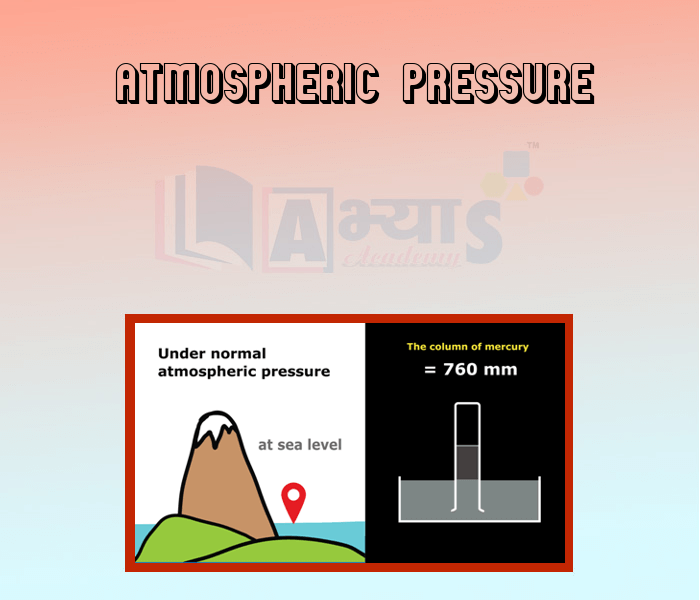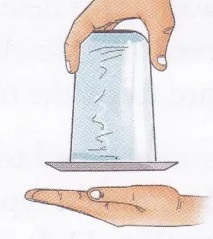Atmospheric Pressure





Atmospheric Pressure
Atmospheric pressure is defined as the pressure exerted on an object by the weight of the air above it. The atmospheric pressure on the Earths surface at sea level is about one hundred thousand pascal, i.e., 100 kPa.
| Measuring atmospheric pressure: An instrument called barometer is used to measure atmospheric pressure. It consists of long and thin tube filled with mercury and closed at one end. The open end of the tube is placed in a small trough full of mercury. The pressure exerted by air on the mercury of trough is able to hold certain height of the mercury column. When the air pressure is low, the mercury will move down, and when the air pressure increases the height of the mercury column increases. We can measure the pressure by the weight of mercury column in mm of Hg. Note: At sea level, the atmospheric pressure is 760 mm of Hg and is taken to be equal to 1 atmospheric pressure, i.e., 760 mm of Hg = atmospheric pressure at sea level. |  |
Variation of Atmospheric Pressure:
Aim: To show the presence of atmospheric pressure. Materials needed: A glass tumbler (with a smooth edge at the mouth, and withour a rim), a piece of stiff cardboard ( a little bigger than the mouth of the tumbler), and water. (It would be convenient to perform this activity over a wash basin or the kitchen sink.) Method: Observation: You will observe that the cardboard piece will not fall. Conclusion: Atmospheric pressure provides enough force to support a full glass of water. |  |
Which of the following are correct : (a) The pressure of the atmosphere is not uniform. (b) The pressure of the atmosphere is uniform. (c) Atmospheric pressure is measured by barometer. | |||
| Right Option : C | |||
| View Explanation | |||
Which of the followinh statement is NOT true. | |||
| Right Option : B | |||
| View Explanation |
Barometer is used for measuring: | |||
| Right Option : C | |||
| View Explanation |
Students / Parents Reviews [10]
My experience with Abhyas is very good. I have learnt many things here like vedic maths and reasoning also. Teachers here first take our doubts and then there are assignments to verify our weak points.

Shivam Rana
7thBeing a parent, I saw my daughter improvement in her studies by seeing a good result in all day to day compititive exam TMO, NSO, IEO etc and as well as studies. I have got a fruitful result from my daughter.

Prisha Gupta
8thMy experience with Abhyas academy is very good. I did not think that my every subject coming here will be so strong. The main thing is that the online tests had made me learn here more things.

Hiya Gupta
8thI have spent a wonderful time in Abhyas academy. It has made my reasoning more apt, English more stronger and Maths an interesting subject for me. It has given me a habbit of self studying

Yatharthi Sharma
10thA marvelous experience with Abhyas. I am glad to share that my ward has achieved more than enough at the Ambala ABHYAS centre. Years have passed on and more and more he has gained. May the centre flourish and develop day by day by the grace of God.

Archit Segal
7thMy experience was very good with Abhyas academy. I am studying here from 6th class and I am satisfied by its results in my life. I improved a lot here ahead of school syllabus.

Ayan Ghosh
8thOne of the best institutes to develope a child interest in studies.Provides SST and English knowledge also unlike other institutes. Teachers are co operative and friendly online tests andPPT develope practical knowledge also.

Aman Kumar Shrivastava
10thIt has a great methodology. Students here can get analysis to their test quickly.We can learn easily through PPTs and the testing methods are good. We know that where we have to practice

Barkha Arora
10thAbhyas Methodology is very good. It is based on according to student and each child manages accordingly to its properly. Methodology has improved the abilities of students to shine them in future.

Manish Kumar
10thAbhyas is a complete education Institute. Here extreme care is taken by teacher with the help of regular exam. Extra classes also conducted by the institute, if the student is weak.
